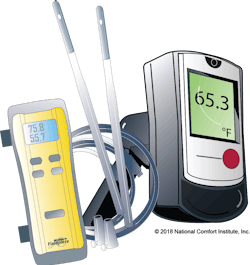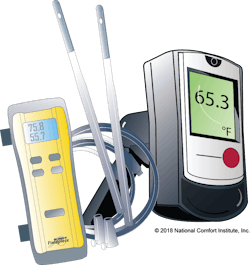Expand Your HVAC Diagnostics by Measuring Web Bulb Temperature
In the last article, we looked at the limitations of dry bulb temperatures. However, when combined with fan airflow and the sensible heat formula, dry bulb temperatures can determine the sensible Btus of HVAC equipment. This article will cover another temperature reading with limitations when taken out of context. Let's look at how wet-bulb temperatures can expand your diagnostics and check total equipment cooling performance.
Wet-Bulb Temperature
Many technicians are familiar with wet-bulb temperature measurement as a step to determine the correct refrigerant charge in a cooling system. Unfortunately, this is often where its use ends. This measurement has so much more potential if you take it a little further.
Wet bulb temperature is a complicated concept to define. It's described as the temperature measured using a sensing device covered with a water-saturated wickYou can measure wet bulb temperature using a digital psychrometer, sling psychrometer, or a standard thermometer with a wick soaked in distilled water. For best results, use a digital psychrometer to measure inside the duct system at the indoor equipment. Measurements taken at a return grille do not reflect the true wet bulb temperature entering the air handling equipment because of duct leakage. This is a major issue with return ducts in an attic or crawlspace.
Latent Heat and Total Heat
Besides sensible heat, a cooling system can also remove latent heat. This part of system operation is vital in humid climates because it accounts for humidity removal. When you combine latent heat and sensible heat, the result is the total heat removed by the cooling system.
The total heat formula is: CFM x Δh x 4.5 = Total Btus
- CFM is the volume of air moving across the indoor coil
- Δh is the enthalpy change (more on that later) across the indoor coil
- 4.5 is a multiplier consisting of the weight of standard air (.075) multiplied by minutes in an hour (60).
To use this formula, measure wet bulb temperatures as air enters and exits the air handling equipment. Now convert those measurements to enthalpy using an enthalpy chart or psychrometric calculator. If you're wondering, enthalpy is a fancy word for heat often used to describe how much heat one pound of air contains under different conditions. You'll often see this expressed as Btu/lb.
Once you convert wet-bulb temperature measurements to enthalpy, subtract the two to determine enthalpy change or Δh (Delta h) through the cooling system. Remember, the "h" stands for heat.
To shortcut a few of these steps, you can use newer digital psychrometers that measure enthalpy directly and calculate Δh. If you're considering investing in a psychrometer, purchase a model that automatically does the enthalpy calculations. You can thank me later.
After determining enthalpy change, combine it with fan airflow and the total heat formula to determine total system capacity. You can use this value to verify installed cooling system performance instead of guessing. Let's look at how the total heat formula can expand your diagnostics.
Total Heat Formula Application
Let's say you receive a call from a homeowner who has a four-ton cooling system that doesn't seem to work as they expect. They are uncomfortable and think they need a larger system. After getting advice from a family member, they seal their duct system to reduce leakage. Unfortunately, this step only makes their problem worse.
When you arrive at the home, you measure fan airflow and find the air handler moving 1160 cfm. You also measure 63.1˚F return air wet-bulb temperature entering the air handler. With an enthalpy chart, you convert 63.1˚F wet bulb to a 28.65 Btu/lb (Btus per pound of air). Note: If you had newer digital psychrometers, you would measure enthalpy directly and skip this step.
Next, you measure 53.4˚F supply air wet-bulb temperature leaving the air handler. This measurement converts to 22.24 Btu/lb. Subtract the 22.24 supply enthalpy from the 28.65 return enthalpy to find a 6.41 Δh (enthalpy change). Plug these measurements into the total heat formula as follows:
1160 CFM x 6.41Δh x 4.5 = 33,460 total Btus
When you compare the 33,460 Btus you just calculated to the four-ton rated system, you find the equipment operates closer to a three-ton system. Do you think larger equipment will solve this customer's problem? What about any duct losses due to duct temperature gain? How would it affect this system's performance?
Keep Total Heat in Context
Applying the total and sensible heat formula we covered in the last article gives you new insight into actual HVAC system operation. Try to use these formulas when you encounter comfort and performance issues. Often, they contain answers to your most challenging problems. However, you need to keep the results in context, or they might be misleading.
It might seem odd, but you can have a cooling system with the right amount of total Btus and still cannot correctly condition the home. That's because sensible Btus drive the thermostat. It only cares if the living space temperature is being lowered. Low airflow messes with sensible capacity. In fact, it reduces it.
Manufacturers determine the ratio of total Btu capacity and express it as the Sensible Heat Ratio (SHR). The SHR shows you how much of the equipment's total cooling Btus goes to sensible Btu removal and how much goes to latent Btu removal. Older equipment typically had an SHR of .70, while newer equipment is often .85 or higher.
It's easiest to think of the ratio as a percentage. So, if the SHR is .70, that means 70% of the equipment's total Btu capacity is sensible and responsible for lowering the space temperature. The remaining 30% handles the latent Btu or moisture removal side.
If you've ever replaced older equipment with newer equipment and wondered why it didn't dehumidify or cool as well as the older system, you may have just had an AHA! Moment. This is one of many reasons the equipment selection procedures in ACCA Manual S are so necessary.
Match the equipment to handle the load of the building. Don't just swap out like-for-like based on model numbers and nominal tonnage -- doing so will get you in trouble. Instead, work to prevent these issues from happening. If you encounter these problems, use the equipment manufacturer's specifications and the two formulas we covered to guide you toward a solution.
David Richardson serves the HVAC industry as Director of Training for the National Comfort Institute, Inc. (NCI). NCI specializes in training that focuses on improving, measuring, and verifying HVAC and Building Performance.
If you're an HVAC contractor or technician interested in learning more about testing system performance, contact David at ncilink.com/ContactMe or call 800-633-7058. NCI's website, www.nationalcomfortinstitute.com, contains free technical articles and downloads to help you improve your professionalism and strengthen your company.About the Author
David Richardson
Director, technical curriculum
David Richardson serves the HVAC industry as director of technical curriculum at National Comfort Institute, Inc. (NCI), Avon, Ohio. NCI specializes in training that focuses on improving, measuring, and verifying HVAC and Building Performance.

